Tom's Guide Verdict
Nvidia’s RTX 5060 Ti is a real statement piece for DLSS 4 — showcasing huge framerates in plenty of top games at an impressive cost. It’s not worth it for 40-series owners, given the small gains in raw rendering and content creation performance. But if you’re on older cards or looking to get into PC gaming for the first time, this is a great start.
Pros
- +
Powerful 1440p gaming
- +
DLSS 4 really impresses
- +
4K single-player gaming is great
- +
Decent mid-range content creation performance
- +
Affordable pricing…
Cons
- -
…provided you can find one at MSRP
- -
128-bit bus can cause bottlenecks
- -
8GB will not be enough
Why you can trust Tom's Guide
While the RTX 5090 is the supercar to get people through the door, Nvidia’s GeForce RTX 5060 Ti is the more cost effective option you walk out with the keys to.
Not only is this a solid mid-range GPU, the DLSS 4 capabilities unlocked by this give you versatility in its performance.
Games that support the likes of multi-frame generation absolutely shine on the RTX 5060 Ti — the same as any creative or AI workload that really makes the most of its rendering prowess or the vastly increased number of AI-centric Tensor cores.
Step outside of Nvidia’s playground (and the company's cherry-picked numbers to really brag about the card, and you will notice the gains are only minor compared to the 4060 Ti. So if you are using a PC with this card, I’d recommend waiting it out — you already get most of the DLSS 4 features anyway!
Plus, the decision to stick to the same 128-bit memory bus as the previous generation GPU (how much data can be moved per clock cycle) does make for some small bottleneck moments.
Yes, some of the neural rendering techniques do compress the data that needs to be transferred with AI, but when you need that raw performance on multiplayer games, you need to tone down the use of DLSS and it can be felt.
However, if you’re on anything older than that (3060 or older), the improvements in game performance and working speeds are significant. And at this price (provided brands stick to the MSRP), all of that in-game AI trickery really starts to make sense..
Just make sure you pick the right 5060 Ti! Sure, there is a cheaper version with 8GB of GDDR7 video memory for $379. But no matter what AI optimizations can be made to the size demands of graphics, you’re seeing many AAA games blast past that.
With 16GB of video memory, you’ve got a little more headroom for just $50 extra. Though it is worth noting we haven't been given the 8GB model to test, so this is all theoretical based on my experience with 16GB.
How Tom’s Guide reviews GPUs
Read more ▼
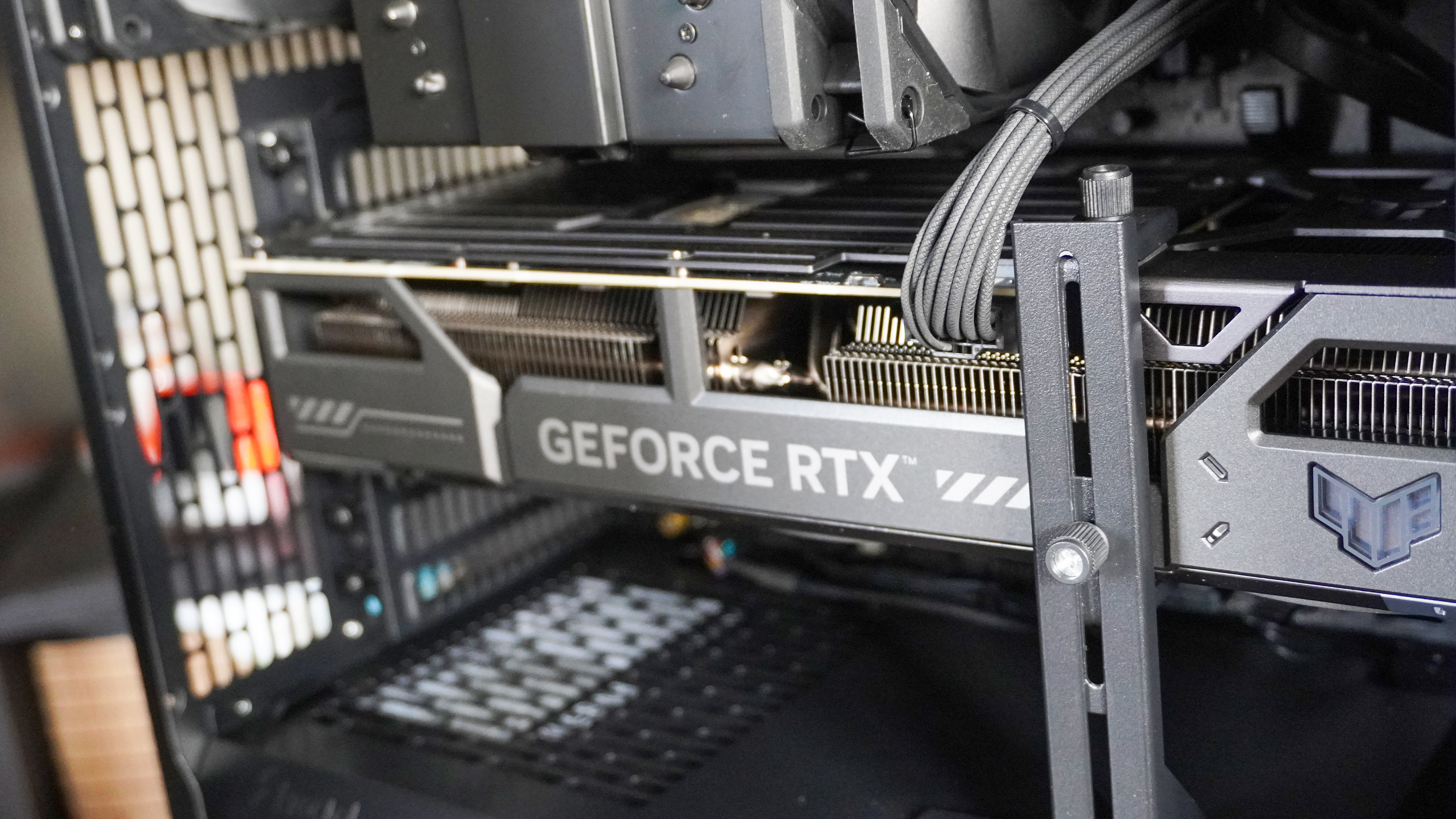
We test every GPU that’s announced and launched in many different ways — be it in the best gaming laptops or the full-blown desktop monsters in the best gaming PCs.
But this is the first actual GPU review we have done in the many years of Tom’s Guide, so as Managing Editor of Computing, it’s only fair that I set the ground rules of what to expect from graphics card reviews. And each one we do will answer three questions:
- How well does it play my games?
- What work can I get done with it?
- Is the price fair for what you get?
For these, we are not reviewing the specific make/model of the GPU, but rather the whole GPU standard as a whole — the RTX 5060 Ti rather than the Palit Infinity RTX 5060 Ti.
Sure, we’ll let you know which one we’re testing (and our numbers will come from there), but we’re using these numbers as a frame of reference for what you can expect to get out of any 5060 Ti.
Of course there will be small variances that come with the cooling used and clock speeds, but we want to answer the three questions above for everyone — be it an experienced PC builder, someone buying a GPU for the first time, or somebody looking to buy a pre-built gaming PC with this level of GPU in it.
If you’re looking for a dense level of detail and analysis on specific cards, our friends over at Tom’s Hardware can help you out! For frame of reference, we’ll be using some of our sister site’s testing data of older cards too.
Nvidia GeForce RTX 5060 Ti: Cheat Sheet
- What is it? This is a lower mid-range PC graphics card.
- Who is it for? This is for people who are looking for smooth 1440p gaming performance at high-maxed settings.
- What does it cost? MSRP starts at $379, but expect the price to be a little more expensive from vendors.
- What do I like? For the price you’re paying, this is a stellar GPU for uber smooth 1440p gaming performance. Not only that, but DLSS could even help you run at 4K at over 100 FPS in some games. Impressive gains can also be found in content creation and AI workloads too — thanks to those next generation AI cores.
- What don’t I like? As with any GPU, I’m a little suspicious of the MSRP. Fingers crossed any increases stay below 5%, but given the up to 20% uplift we’ve seen on the other 50-series cards, I’m not optimistic.
Nvidia GeForce RTX 5060 Ti: Specs
| Header Cell - Column 0 | RTX 5060 Ti | RTX 4060 Ti |
|---|---|---|
Price | $379/£349 (8GB) / $429/£399 (16GB) | $499 at launch |
Video memory | 8GB GDDR7 / 16GB GDDR7 | 8GB / 16GB GDDR6 |
RT Cores | 36 4th Gen cores | 34 3rd Gen cores |
Tensor Cores | 144 5th Gen cores | 136 4th Gen cores |
CUDA Cores | 4,608 | 4,352 |
Power consumption (TDP) | 180W | 140W |
Ports | 1x HDMI 2.1, 3x DisplayPort 1.4a | 1x HDMI 2.1b, 3x DisplayPort 2.1b |
Nvidia GeForce RTX 5060 Ti: 3DMark tests
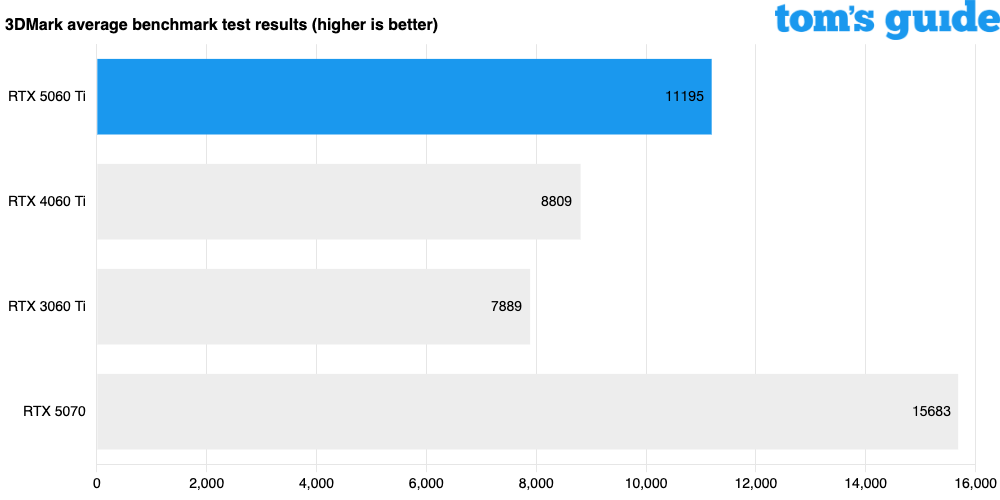
Nvidia GeForce RTX 5060 Ti: The ups
So as you can see, GPU performance in gaming benchmarks is seeing an average 27% uplift over the previous generation, and even more over the 30-series. But that’s just half the story.
DLSS changes the game
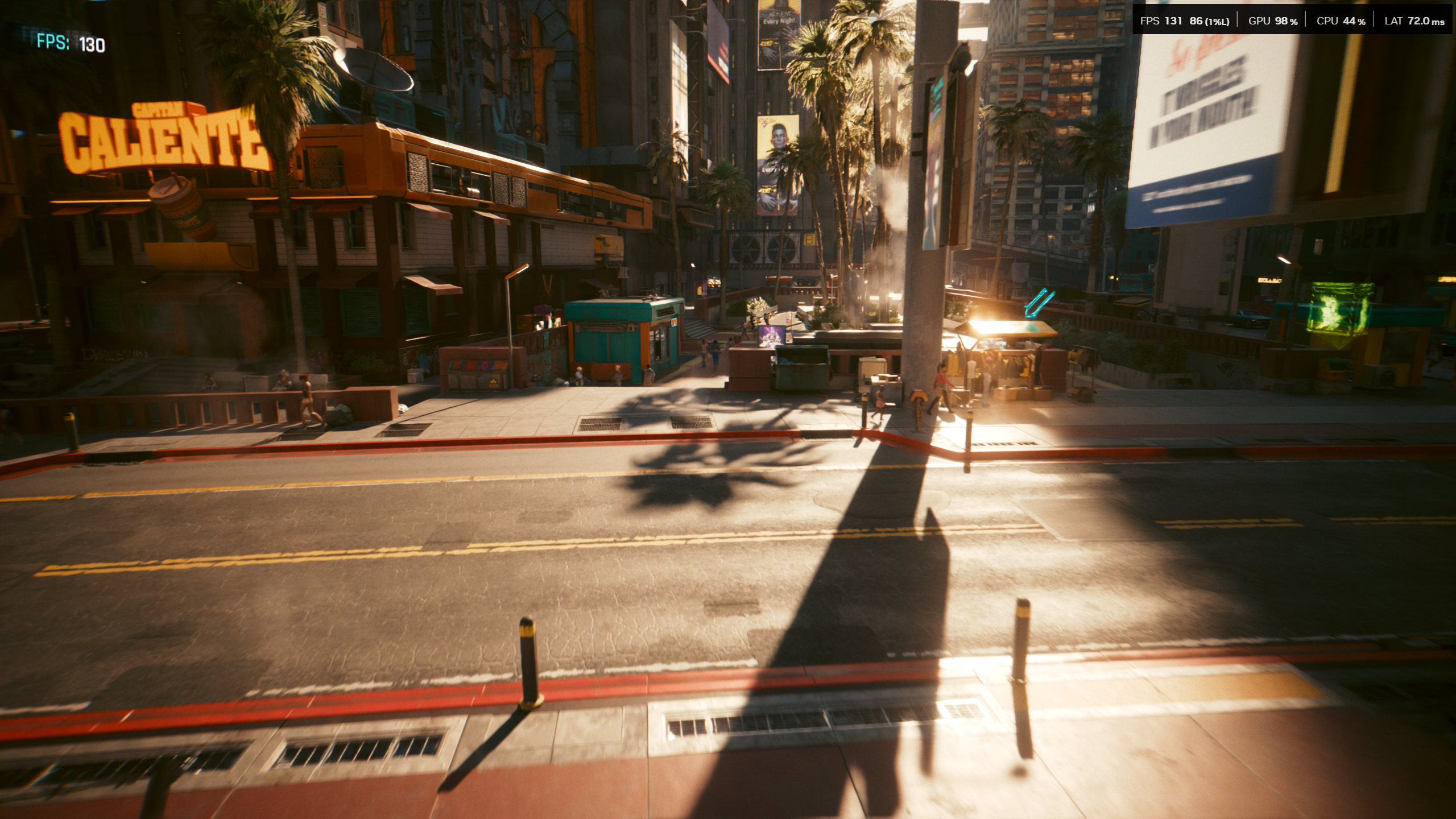
Nvidia’s target for the RTX 5060 Ti is 1440p, and it should come as no surprise that it delivers. What did surprise me, however, is just what it is capable of and how much DLSS just makes sense here.
You see in more expensive cards, dropping up to two grand on a 5090 to just be told to use DLSS can leave a bit of a bad taste in potential buyers’ mouths. But to see it in a far cheaper GPU like this, and how it can unlock impressively smooth gameplay at even 4K is bonkers.
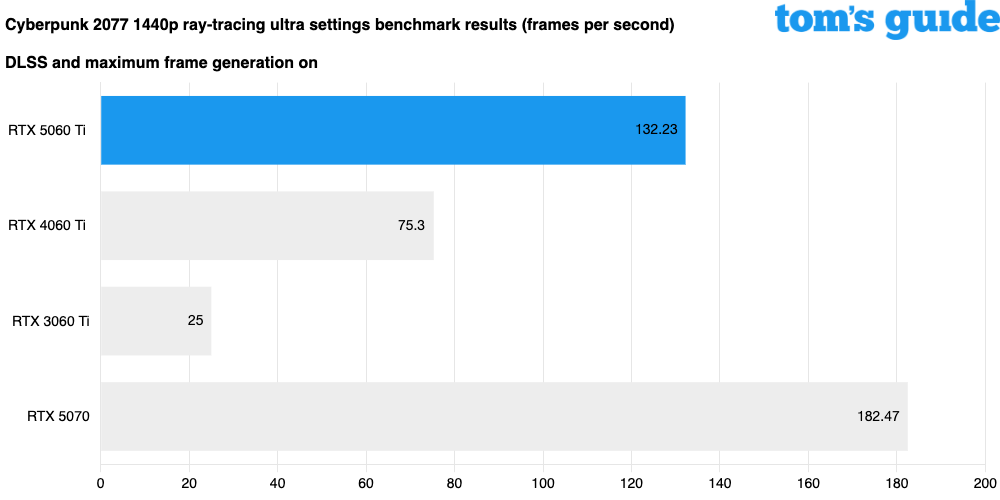
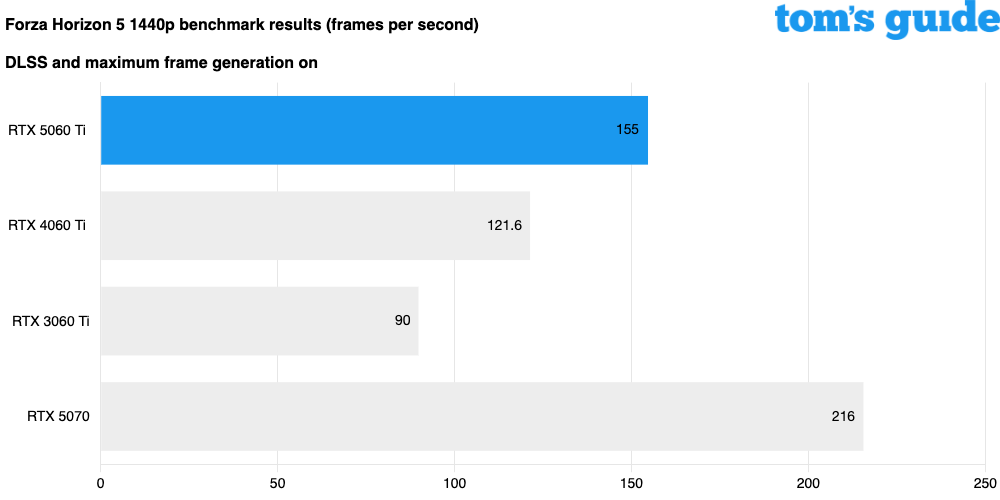
Multi-frame gen uses AI to construct 3 additional frames alongside the 1 rendered frame, but as you can see, it’s overperforming here. Being able to get over 100 FPS at 4K ray-tracing: ultra settings on Cyberpunk 2077 is a stellar achievement in a $430 card.
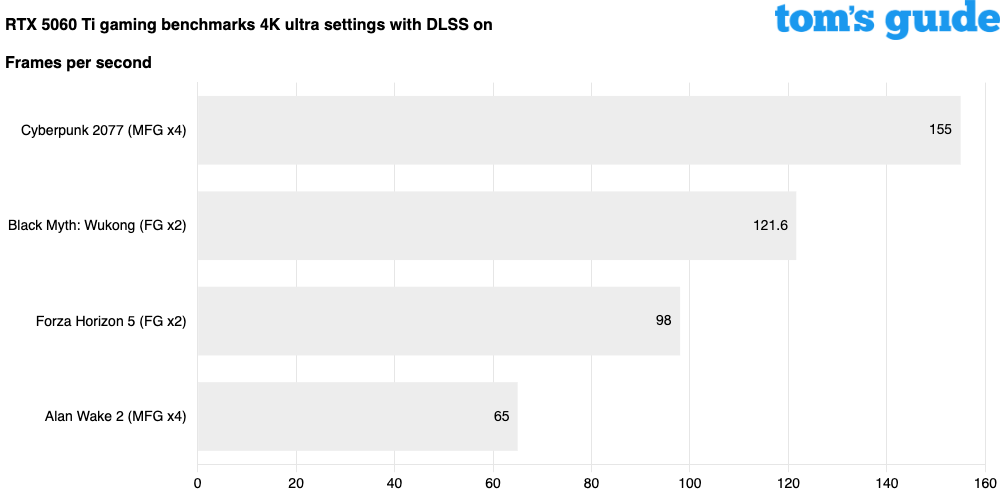
Pair that with moving from the Convolutional Neural Network (CNN) model of DLSS 3 that analyzed images on the fly to a Transformer Model (working more like ChatGPT does), and the vast drop in image ghosting on fast-moving objects means most people won’t notice any sort of outlines.
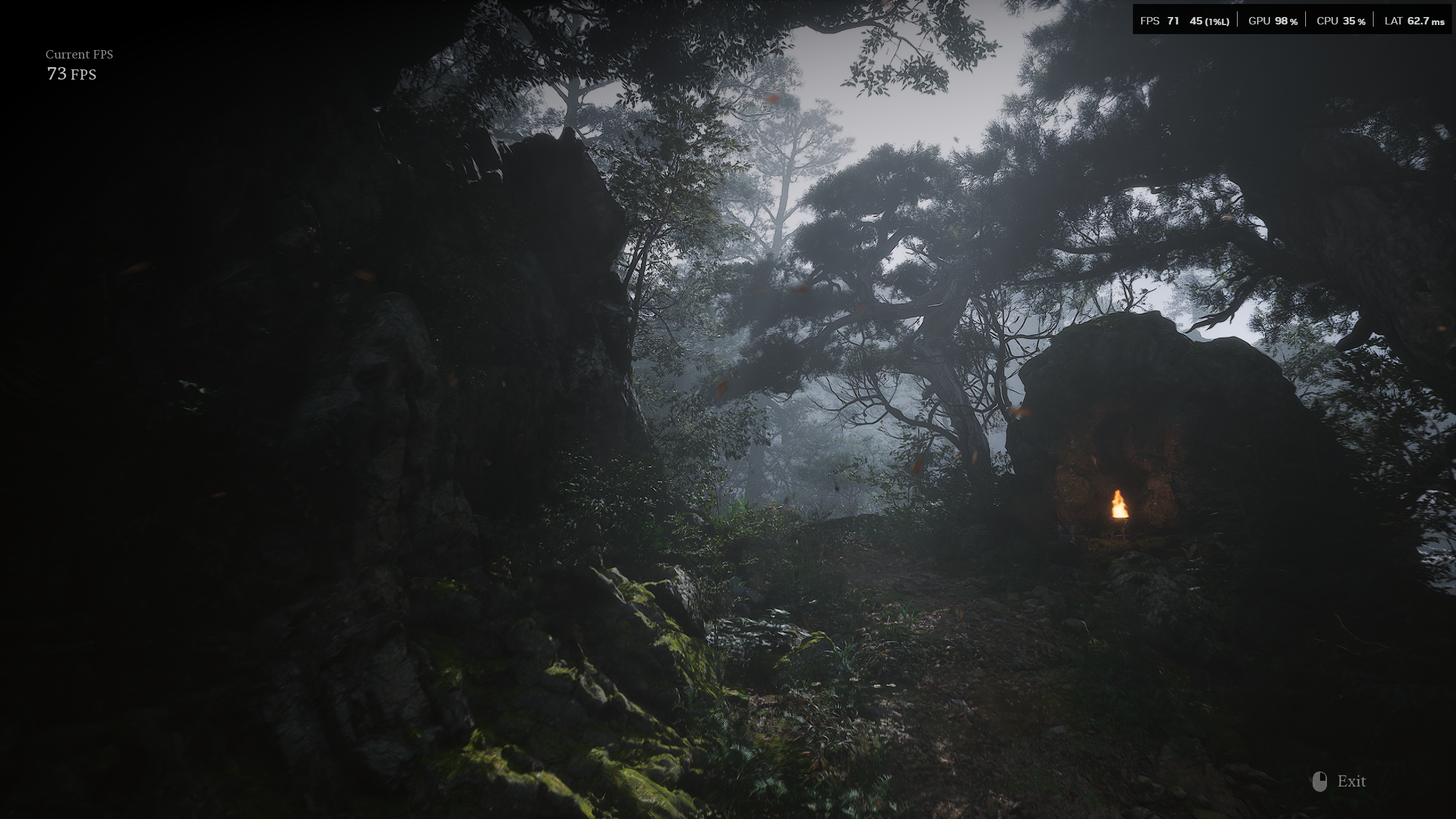
That is unless you pixel peep and maybe see the odd artifacting around a character’s hair. Also, it’s worth noting this Transformer Model is coming to RTX 4060 Ti too (minus the multi-frame gen).
Of course, there are potential latency issues here, which Reflex does help with in games like Forza Horizon 5. And on top of that, when you look at the raw rendering performance, you start to see how small the gains are here over the 4060 Ti.
GPU | Cyberpunk 2077 ray tracing ultra 1440p | Forza Horizon 5 max settings 1440p |
|---|---|---|
RTX 5060 Ti | 53.24 FPS | 121 FPS |
RTX 4060 Ti | 47.3 FPS | 115.5 FPS |
RTX 3060 Ti | n/a | 88 FPS |
RTX 5070 | 66.46 FPS | 171 FPS |
But that clearly isn’t Nvidia’s focus here — AI performance boosting and neural rendering is. A lot of people use DLSS, and in a cheaper GPU, this hits the bullseye.
Decent mid-range uplift in content creation performance

If your purpose with your GPU extends beyond making your games look good, just like anything else, there’s an upward trend between what you pay and what you get — highlighted especially by testing it as a workstation for content creation.
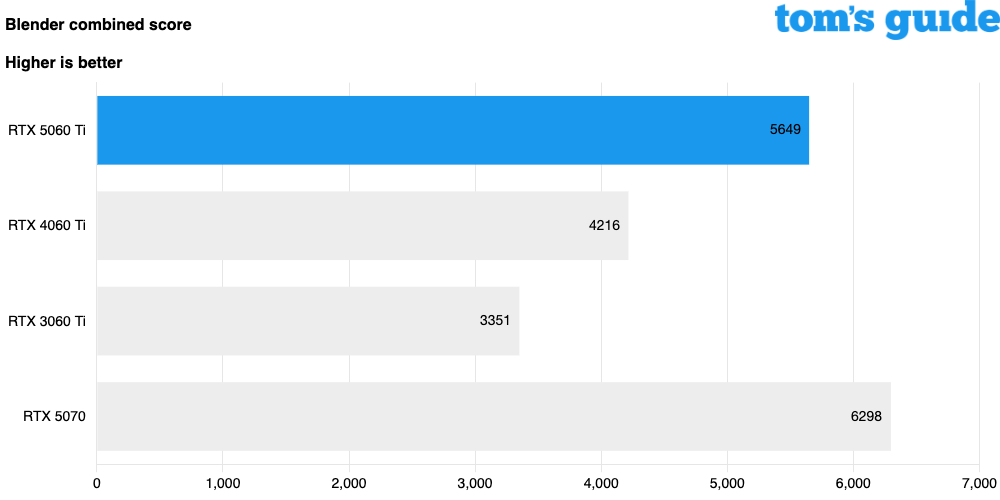
Blender is a good GPU-intensive test of video and graphics rendering, and as you can see, the CUDA cores responsible for rendering give the 5060 Ti a healthy 37% increase in performance over 4060 Ti, and a nice 69% over 3060 Ti.
But as a bit of an enthusiast in both of these, this is strong for prosumer work and rendering video (or animation) edits.
Nvidia GeForce RTX 5060 Ti: The downs
The RTX 5060 Ti has several notable strengths, but there are a couple of elements that stop it just short of being a multi-purpose all-around perforrmer.
Some multiplayer struggles

When it comes to playing online multiplayer games, three things matter: raw rendering performance (DLSS can be a distraction), high frame rates and low latency times (anywhere below 10ms is good). And this seems to be the one weak point of the RTX 5060 Ti in our testing.
GPU | Frames per second | Latency (ms) |
|---|---|---|
RTX 5060 Ti (1080p) | 107 | 11.3 |
RTX 5070 (1080p) | 186 | 8.9 |
RTX 5060 Ti (1440p) | 80 | 27.2 |
RTX 5070 (1440p) | 139 | 16.2 |
Of course, this is only on maximum settings. You can fiddle with them to bring that demand down and improve the frame rate and latency. But given the higher memory bandwidth, stuffing it through a 128-bit bus seems to create a bit of a bottleneck situation under high stress like this.
If you don’t want to compromise the fidelity in multiplayer, you’ll need to step your GPU investment up.
Only minor AI performance uplifts

While content creation improvements are solid here, and chances are with more machine learning coming to video editing apps, you’ll see those Tensor cores come in strong. If you need strong AI workload performance, the RTX 5060 Ti is decidedly mid-range with only small uplifts over the 4060 Ti.
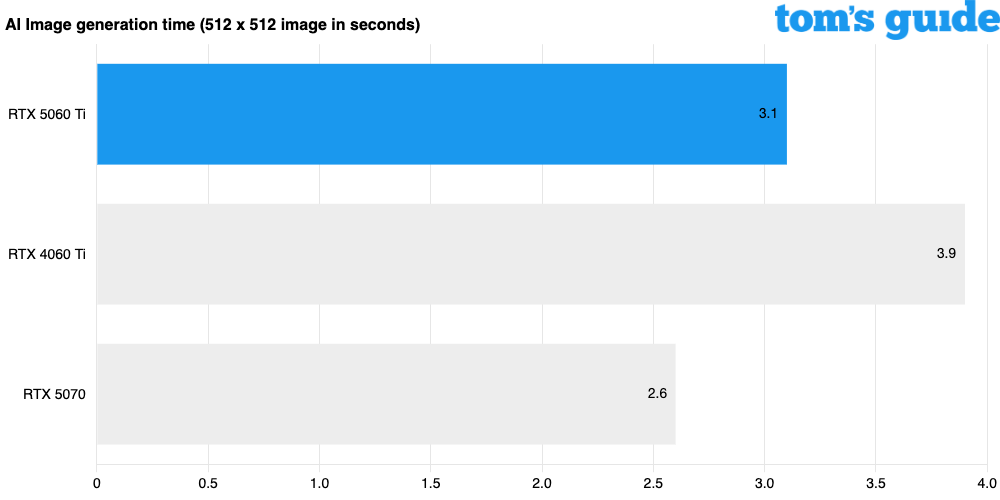
Of course, if this is a key focus of buying a GPU for you, then you’re going to get more throwing more money at it — be it the 5070 and higher, or even possibly going for a 4080 or 4090 (a 4090 can generate an image in this test in under a second).
Benchmark | Result |
|---|---|
AI Computer vision (Nvidia) | 1159 |
AI image gen Stable Diffusion XL | 1811 |
Phi-3.5-mini-instruct | 3084 |
Llama-3.1-8B | 2642 |
But for people getting enthusiastic about AI, this offers a decent-enough local prowess given the speed of image generation and running local LLMs.
Nvidia GeForce RTX 5060 Ti: Verdict

So where does this leave the RTX 5060 Ti GPU? Put simply, it’s the GPU where DLSS 4 really makes sense.
While raw performance has seen a small uplift over 4060 Ti, the focus on AI in this card really unlocks performance that outstrips what other GPUs are capable of at this price.
But that doesn’t mean it’s a worthwhile purchase for everyone. You’re going to fit into one of these categories:
- I already have an RTX 4060 Ti: This is not worth getting — your 4060 still has legs for a while to come.
- I have an RTX 3060 Ti or earlier: Provided the prices are good, then the 5060 Ti is an impressive generational leap of an upgrade to get.
- I’m a first-time PC gamer: This is a recommended buy — be it on its own or as part of a pre-built. DLSS 4 unlocks impressive frame rates with top visual fidelity that isn’t compromised too much by ghosting.
- Multiplayer is my jam: This is a bit more in the air. If the devil is in the high fidelity detail for you without more latency, then the 5070 is probably the way to go. But you can tune the settings down here to get that sub 5ms (or use Reflex).
But like I said, just make sure you target the version with 16GB of video memory. Given the subtle moments of bottleneck I got with this higher configuration, I’m confident that 8GB is going to have a tough time right out of the gate.

Jason brings a decade of tech and gaming journalism experience to his role as a Managing Editor of Computing at Tom's Guide. He has previously written for Laptop Mag, Tom's Hardware, Kotaku, Stuff and BBC Science Focus. In his spare time, you'll find Jason looking for good dogs to pet or thinking about eating pizza if he isn't already.
You must confirm your public display name before commenting
Please logout and then login again, you will then be prompted to enter your display name.

